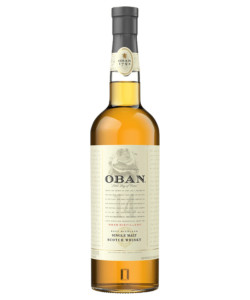Along the shore of the Firth of Lorn, one will find Oban, a small Scottish town now most notable for its namesake distillery. The Oban distillery was opened by brothers John and Hugh Stevenson in 1794 on the grounds of the defunct Oban brewery, opened by the Stevenons the year prior. In Oban’s over 200 years of operations, production measures — as well as where those production measures take place — haven’t changed once.
Today, Oban — meaning “little bay” in Gaelic — distills approximately 670,000 liters of Scotch whisky per year, remaining steadfast in its commitment to tradition, despite the fact that this may reduce its production volume. Now that you know the basics, here are seven things you should know about Oban whisky.
Oban Whisky is older than the town it’s made in.
When Oban was opened by the Stevensen brothers in 1794, there was no surrounding town for the distillery to call home. Prior to the distillery’s construction, the coastal area was occupied by minor fishing, shipbuilding, and quarrying industries with very few residents. The town of Oban was instead constructed around the distillery and was recognized as an official burgh of barony — a type of Scottish town — in 1811. Brothers John and Hugh managed operations at the distillery until Hugh passed in 1820, at which point his son Thomas took over.
The distillery has never moved locations or expanded in size.
As the town of Oban was constructed around its distillery, expanding the size of the facility was next to impossible. As the town and its whisky production continued to grow, the only way to expand production would have involved completely relocating the distillery from its waterfront location, which the Stevensons inevitably decided against. Today, Oban is one of the smallest distilleries in Scotland, taking up just over one square acre and sitting only 208 steps away from the Scottish seaside. Of the distilleries under the Diageo umbrella, Oban is the second-smallest producer in terms of volume, only outproducing Royal Lochnagar.
The distillery is operated by just seven employees.
Oban’s small size is a point of pride for the brand, which believes that “out of this smallness comes a scrupulous attention to detail, reverence for tradition, and world-class whisky.” In order to produce this world-class whisky, just seven people are involved: Ronald “Ronnie” Whiteford, Ricky Halcros, Norman Macfarlane, Patrick Steeman, Timothy Bowels, Scott Jordan, and Derek MacLean. MacLean marks the third generation of men in his family to work at Oban.
Oban’s distillers are committed to upholding tradition.
As Oban’s location and size have remained the same since its beginnings in the 18th century, it’s only fitting that the distillation process has stayed true to its origins as well. To start, Scottish malted barley sourced from Burghead Maltings is ground in a decades-old mill to produce grist, which is then added to a traditional mash tun — one of the few that remain in Scotland — and combined with hot water sourced from Loch Gleann a’Bharraidh just three miles away. The mash tun then turns exactly six times per week to create batches of wort, the same number of times it was turned when the distillery opened. Though more whisky could be produced by mixing it more times per week, doing so would break over two centuries of precedent and would damage Oban’s commitment to remaining traditional in its practices.
Oban’s yeast ferments for over 100 hours to create the Scotch’s signature flavors.
Once the mash completes its turn through the mash tun, it is placed into washbacks, the vessels in which fermentation takes place. Typically, whisky fermentation is complete around the 48- to 60- hour mark, at which point the wash, which is distilled to produce the whisky, has stopped producing alcohol. In contrast with many whisky distillers, Oban allows fermentation to take place over 110 hours, which does not produce a higher alcohol content but instead allows the distillate to absorb more flavors from the yeast. If allowed to sit for longer than 60 hours, distillates are able to absorb perfumed floral and citrus notes from the yeast, which perfectly complement and balance Oban’s smoky malt and toasted oak qualities.
Oban is made using an almost-obsolete distillation method.
Rather than using shell and tube condensers to condense fermented vapor back into liquid form — which are more modern and can produce higher volumes of product — distillers at Oban still opt to use worm tubs to condense their distillates, making them one of just 15 Scotch distilleries still choosing to do so. Worm tubs — wood vats with copper pipes coiled inside — allow vapor to travel down the copper pipe into a pool of cold water, where it condenses into liquid form.
Copper has an incredible ability to filter out impurities, hence why many modern distillers opt for shell and tube condensers. With this method, spirits have very high contact with copper as they pass through the chamber and condense into Scotch — roughly 100 copper tubes fill a larger copper shell. The result is purer spirits that have had almost all sulfites and other “heavy” compounds removed. However, with worm tub condensing, spirits interact with less copper, which allows some of these “harsher” elements to remain in the distillate. Combined with Oban’s delicate mashing and fermentation processes, the resulting spirit is a fruity, full-bodied Scotch with a hint of smoke and a textured mouthfeel.
There are four Scotches under Oban’s umbrella.
In addition to the flagship Oban 14 Years Old, the distillery also produces three other Scotches to round out its lineup: Oban 18 Years Old, Oban Little Bay, and Oban Distillers Edition. Oban 18 Year expands on the brand’s original expression with an additional four years of age, resulting in rich peat, smoke, and spicy wood flavors in contrast to the 14 Year’s honeyed spice and dry smoke. Little Bay, the English translation of Oban, boasts a sweeter profile than both 14 Year and 18 Year, notable for its notes of Christmas pudding, spiced citrus, and dark chocolate on the finish. The fourth release from Oban, the Distillers Edition, undergoes an additional maturation in Montilla Fino sherry casks before bottling. As such, the Scotch adopts a succulent flavor profile with essences of toffee, butterscotch, and salted caramel.

